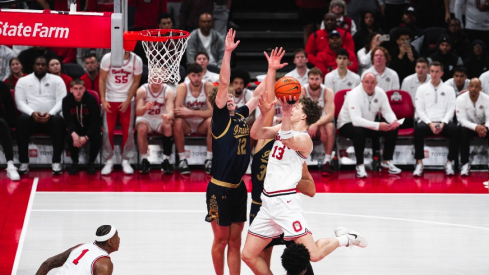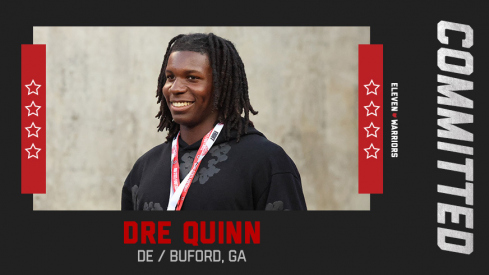
In what was clearly a satisfying performance for Urban Meyer, the Ohio State defense played perhaps its best all-around game yet. Obscured by two late Penn State touchdowns is the fact that the Buckeye defense kept OSU in the game for two and a half quarters, in the face of offensive inefficiency and special teams breakdowns. It was the second consecutive week the Buckeye defense has done so. OSU accomplished this by mixing and matching looks more than at any time this year. The Buckeyes sprinkled in zone blitzes, zone coverages, and ample amounts of man. This disabled the Nittany Lion run game, rendering Penn State one-dimensional and allowing the Buckeyes to make stops.
Let's Put a Smile on That Face
We blitzed more. We had more pressures . . . But we played more man coverage and blitzed more than he did all year. So that's telling us something that we need to do more of that.
Meyer's Monday press conference tells part of the OSU defensive story. The Buckeyes' goal was to attack Penn State in run downs, particularly against the Nittany Lions' '12' (1 RB, 2 TE) personnel. OSU did this in one of two ways. The first was to play cover-1 man and man-robber. As seen below, the OSU inside linebackers would delay blitz if Penn State's back(s) stayed in pass protection. Cover-1 also brought OSU's strong safety CJ Barnett down into the box, placing 8 defenders against the Penn State run game. Penn State could not run against the OSU front plus the aggressive second-level force play.
Alternatively, the Buckeyes would zone blitz, often bringing Ryan Shazier on a 'x-cross' with the defensive tackle.
And, at times against 21 personnel, OSU would bring man blitzes and play cover-0 behind.
Penn State tried to borrow a page from previous opponents and put their twins to the field and TE to the boundary. But the cover-1 largely short circuited this, trading out the strong safety for boundary corner in the box with help over the top. This allowed OSU to maintain the same arithmetic advantage and leverage against the run. Further, the free safety could help the man coverage to the inside, unlike in cover-4 where the safety was committed to the boundary side No. 2 receiver.
Penn State did exploit the Buckeye secondary's issues with double moves. But the Nittany Lions were either not able to convert, or the OSU defense was able to stiffen in response.
Mixin' and Matchin'
In pass situations the Buckeyes moved towards mixing and matching zone looks. This included zone blitzes, but primarily featured a mixing and matching of various zone looks. For instance, on Ryan Shazier's interception return, the Buckeyes used quarter-quarter-half coverage.
OSU continued featuring cover-2 in this situation as well. Up front, the Buckeyes continued their increased use not only of blitzes but also stunts. The goal was to find inexpensive ways to create pressure. The assorted looks kept Penn State off-balance and was a far cry from Indiana, when the Buckeyes largely sat in base cover-4 without movement up front.
Fundamentals...and It Doesn't Hurt to Have the Jimmy and Joes
As Meyer also stated, the Buckeye defense continued to make small improvements in tackling and leverage. This was perhaps most evident against jailbreak screens thrown by Penn State. It is no secret that OSU has struggled with such plays this fall. Penn State tried to exploit this weakness but OSU did far better recognizing, leveraging and containing the play. The inside cutback lanes were eliminated, greatly limiting Penn State's gains.
Much of these improvements were simply the result of increased health allowing individuals to settle into roles. Zach Boren and Nate Williams continue to make a big impact in both playmaking and leadership. Boren's downhill play against the run brings an element this defense previously lacked. For instance, in the video above against the Penn State run game, Boren quickly filled the hole. By doing so, Boren also improves Shazier's effectiveness. Shazier does not have to worry about linemen coming across the backside to block in pursuit. He can maintain better angles, scraping to the ball-carrier and thus use his athleticism more effectively. Concurrently, Williams' brings a very effective force presence to the Sam linebacker position.
Perhaps ironically, the fact he is not a true linebacker has also forced OSU to play more base under fronts, putting additional defenders in the box. The result is that the linebacker position—which was a real weakness—has been upgraded with personnel adjustments.
The defense's presence was also boosted by a more full return to health of two oft-injured contributors—CJ Barnett and Michael Bennett. As Meyer stated, the Buckeyes' primary constraint in playing man coverage was not its corners, but being able to effectively man against the offense's other three eligible receivers. Barnett's full return has increased the Buckeyes' ability to do so. Bennett finally flashed the form that made Meyer so bullish on him pre-season. He is extremely quick and disruptive off the football. He also flashed his athleticism deflecting a wide receiver screen pass. The Buckeyes regularly placed him at the 3-technique with Johnathan Hankins inside, providing the Buckeyes with two disruptive tackles.
My Way
Meyer was clearly excited about the defensive scheme. As he stated,
Q. You mentioned a more aggressive defense. Was that an edict from you that you need more pressure?COACH MEYER: It's not an edict. It's something I've been pushing. I've been pushing a little bit, and we'll continue to push. I think it's having confidence.
Meyer thus left little doubt that this is the style of defense he would prefer to see moving forward. Putting scheme aside, the key for the OSU defense was stopping the Penn State run game. OSU's front four is its strength, and this is one aspect that the Buckeye defense has excelled in throughout the year. This bodes well for its remaining games against offenses predicated upon the run game.
A Word on Punt
The Buckeyes continue to win despite continued punt protection problems. OSU has allowed three blocks this year and teams will continue to attack the OSU punt protection. Seemingly every week OSU slightly varies its look—with continued breakdowns. For instance, even before the blocked punt, Penn State had a rusher come free.
Meyer partly attributed this to ever-changing punt personnel due to injuries. But three punt blocks cannot be entirely attributed to this. The easy answer would be to go to an NFL spread punt formation. This ensures people are blocked inside and have to come from a further angle. But according to Meyer it is not so simple. Instead, he indicates he faces sub-optimal choices between protecting the punter and getting adequate punt coverage.
I think if you sit there like a sitting duck nowadays, we don't have the greatest hang time. We're struggling a little bit with hang time. So you want to free release people. And any time you free release, you're opening up the flood gates for some protection issues. So that's where we've got to spend a lot of time on that right now. Like last night and today, a lot of time just getting this thing cleaned up on who is going to be on it, making sure they're healthy enough to do it, and making sure our roles are intact.
Right now just flat punting the ball is not very good, and he's actually very pretty good at doing our quarter role like we did and making sure we're in sound protection. So we're in a little dilemma right now. . . .
Ideally we've had years where I think one year we had 13 total return yards. Because our belief is you have 6.5 seconds. If you're hitting the ball 4.5 seconds hang time, and 2 seconds get off, that's 6.5 seconds to cover 40 yards. You put really fast people out there and force catches. We're not doing that right now. But at the end of the day you would say what is the best punt? Fair catch. 13 total or some ridiculous small return yards in getting the ball off, we're not there because we don't have the hang time or the distance. I'm just worried about the returners. So we're jury rigging a system, and I won't say it's working very well.
The wide splits thus encourage a free release for coverage but also allow for easy block opportunities should an inside blocker miss an assignment. The Buckeyes must find a way to simply the blocking assignments to prevent such systemic breakdowns.

